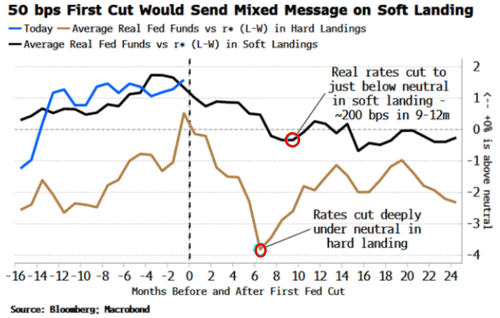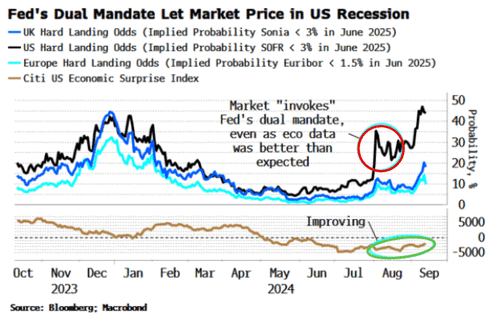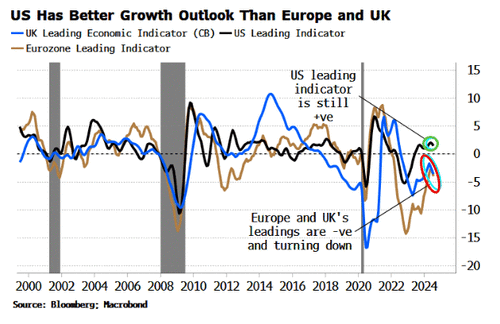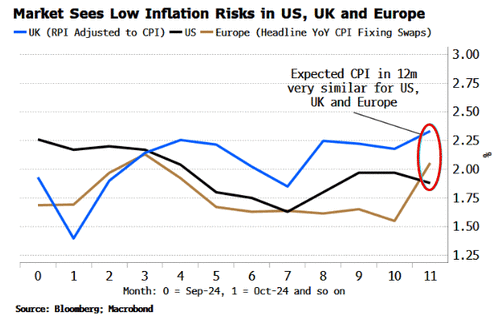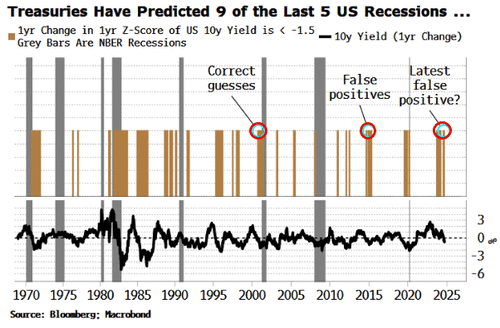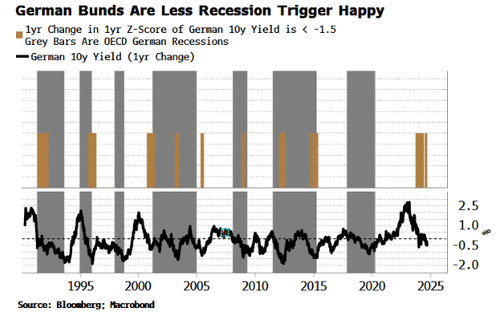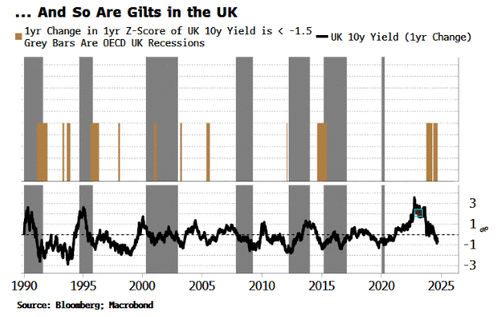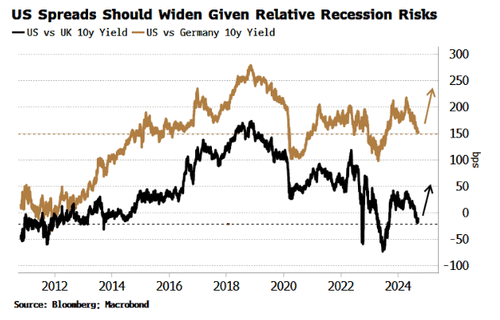Uddrag fra
Debate is intense over whether the Fed’s first cut of the cycle at its meeting this week will be 25 or 50 bps.
There’s about a 70% chance priced it will be a 50, but an outsized cut would mean the Fed sending a mixed message on the soft landing it currently expects. As the chart below shows, the central bank takes real rates back to just under neutral in soft landings, about a 200 bps decline over 9-12 months. A 50-bps first cut would be more in line with the faster and deeper rate reductions seen in hard landings.
Yields are already – likely incorrectly – in the hard-landing camp, and a 50-bps cut may embolden them further.
It was the Japan carry-trade unwind in July and August that initially pushed rates and yields much lower, dramatically marking up the implied likelihood of a US recession. But oddly, the same probabilities in Europe and UK did not rise by nearly as much.
That was strange. From a purely eco-data point of view, near-term recession risk in the US was and is still low, and data releases had been on the whole better than expected, as gauged by the US economic surprise index in the chart above. The market may have been factoring in the increased chance of a recession-causing feedback loop forming between the market and the economy, but if that was the case Europe and the UK should have been in the crosshairs too.
Either way, there is a disconnect. The data justifies a higher risk of a recession in Europe and the UK rather than the US. The chart below shows that the leading indicator for the latter, which leads growth by 3-6 months, is positive and stable, while those of the euro zone and the UK are negative and turning down.
The ECB and the BOE’s single inflation mandates mean that perhaps price-growth concerns are keeping rates supported in Europe and the UK, leading to a lower implied probability of a recession. But even though both central banks have remained cautious on the inflation outlook, in actuality the market sees little difference between where CPI will be in the next 12 months in the US and in the UK and Europe.
So what gives? Bonds’ positive convexity means there is a high risk-reward for betting on a recession at the end of a Fed hiking cycle. Given the Fed’s dual mandate, Treasuries are free to exploit that possibility. That’s not the case in the UK or Europe, where inflation risks can’t be zeroed as they have been in the US.
The problem is, far from their reputation for infallibility, Treasuries often get it wrong. We can observe all of the occasions when US yields have fallen by an amount that has coincided with all previous post-1970 recessions (excluding two of the inflationary downturns where yields were rising, 1974 and 1980). This gives a good recession signal — but it also means many false positives.
In the chart above the brown bars show when the annual change of the one-year Z-score of the US 10-year yield is less than -1.5, i.e. yields fall quite far relative to their recent trend. The gray bars are NBER recessions. We can see that the signal goes off either soon before or during all post-1970 downturns, except 1974 and 1980. But it also goes off multiple other times when there was no recession.
In Europe it’s different. Using the same yield signal as for the US with bunds and German recessions, we get far fewer false positives.
For the UK the signal does give a few false positives, but it’s still much lower at four versus the more than 10 for the US (with the same number of recessions for each country).
The yield signal has recently gone off for all of the US, Europe and the UK. But based on the forecasting record of the individual signals, it’s more likely the yield move is a false positive in the US compared to Europe and the UK.
That outlook is in tune with economic and inflation data shown above, which suggests a recession in the UK and Europe is more likely than one in the US. Yield spreads between the US and Europe and the UK should start widening, with both spreads currently at one-year tights.
The question of when US rates and yields start to reprice with a soft landing as a base case is tricky, as signs that the economy is slowing can be (mis)taken as omens of a recession rather than a more benign easing back in growth.
Nonetheless, if no downturn is forthcoming, and the market gets comfortable with a slowing but still growing economy, then the more aggressive Fed cuts taking the base rate below neutral are likely to be jettisoned.
And yields – after having jumped the gun once again on the Fed’s growth mandate — will climb as the risk-reward of owning recession insurance fades.


